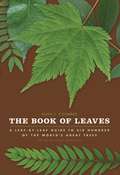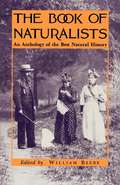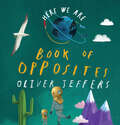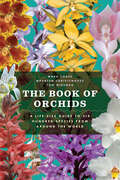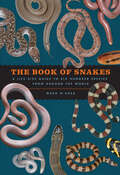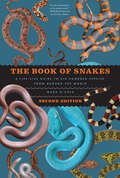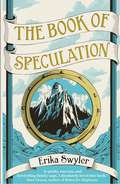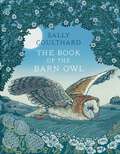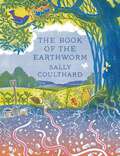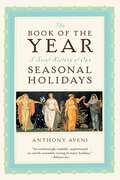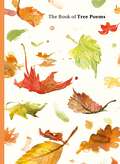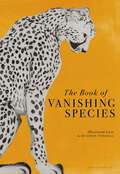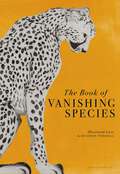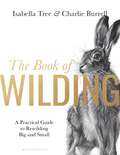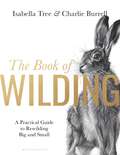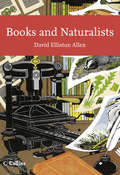- Table View
- List View
The Book of Leaves: A Leaf-by-Leaf Guide to Six Hundred of the World's Great Trees
by Allen J. CoombesOf all our childhood memories, few are quite as thrilling, or as tactile, as those of climbing trees. Scampering up the rough trunk, spying on the world from the cool green shelter of the canopy, lying on a limb and looking up through the leaves at the summer sun almost made it seem as if we were made for trees, and trees for us.Even in adulthood, trees retain their power, from the refreshing way their waves of green break the monotony of a cityscape to the way their autumn transformations take our breath away. In this lavishly illustrated volume, the trees that have enriched our lives finally get their full due, through a focus on the humble leaves that serve, in a sense, as their public face. The Book of Leaves offers a visually stunning and scientifically engaging guide to six hundred of the most impressive and beautiful leaves from around the world. Each leaf is reproduced here at its actual size, in full color, and is accompanied by an explanation of the range, distribution, abundance, and habitat of the tree on which it’s found. Brief scientific and historical accounts of each tree and related species include fun-filled facts and anecdotes that broaden its portrait. The Henry’s Maple, for instance, found in China and named for an Irish doctor who collected leaves there, bears little initial resemblance to the statuesque maples of North America, from its diminutive stature to its unusual trifoliolate leaves. Or the Mediterranean Olive, which has been known to live for more than 1,500 years and whose short, narrow leaves only fall after two or three years, pushed out in stages by the emergence of younger leaves. From the familiar friends of our backyards to the giants of deep woods, The Book of Leaves brings the forest to life—and to our living rooms—as never before.
The Book of Leaves: A Leaf-by-Leaf Guide to Six Hundred of the World's Great Trees
by Allen J. CoombesOf all our childhood memories, few are quite as thrilling, or as tactile, as those of climbing trees. Scampering up the rough trunk, spying on the world from the cool green shelter of the canopy, lying on a limb and looking up through the leaves at the summer sun almost made it seem as if we were made for trees, and trees for us.Even in adulthood, trees retain their power, from the refreshing way their waves of green break the monotony of a cityscape to the way their autumn transformations take our breath away. In this lavishly illustrated volume, the trees that have enriched our lives finally get their full due, through a focus on the humble leaves that serve, in a sense, as their public face. The Book of Leaves offers a visually stunning and scientifically engaging guide to six hundred of the most impressive and beautiful leaves from around the world. Each leaf is reproduced here at its actual size, in full color, and is accompanied by an explanation of the range, distribution, abundance, and habitat of the tree on which it’s found. Brief scientific and historical accounts of each tree and related species include fun-filled facts and anecdotes that broaden its portrait. The Henry’s Maple, for instance, found in China and named for an Irish doctor who collected leaves there, bears little initial resemblance to the statuesque maples of North America, from its diminutive stature to its unusual trifoliolate leaves. Or the Mediterranean Olive, which has been known to live for more than 1,500 years and whose short, narrow leaves only fall after two or three years, pushed out in stages by the emergence of younger leaves. From the familiar friends of our backyards to the giants of deep woods, The Book of Leaves brings the forest to life—and to our living rooms—as never before.
The Book of Naturalists: An Anthology of the Best Natural History
by William BeebeAnyone curious about animals, nature, or the history of biology will find much of interest in this ample and varied collection. Reflecting his infectious enthusiasm for "the best natural history," Beebe's personal assortment of favorites includes excerpts from massive sources, such as Audubon and Darwin, and intriguing pieces from lesser known authors most of us would not normally encounter. Arranged in chronological order, the small masterpieces here range from Aristotle to Rachel Carson. Each of them is introduced by an incisive and sometimes humorous description of its author.
Book of Opposites (Here We Are)
by Oliver JeffersA spectacular concept book from world-renowned artist Oliver Jeffers, based on his million-copy selling, global phenomenon Here We Are!
The Book of Orchids: A Life-Size Guide to Six Hundred Species from around the World (Book Of Ser.)
by Mark W. Chase Maarten J. Christenhusz Tom MirendaOne in every seven flowering plants on earth is an orchid. Yet orchids retain an air of exotic mystery—and they remain remarkably misunderstood and underappreciated. The orchid family contains an astonishing array of colors, forms, and smells that captivate growers from all walks of life across the globe. Though undeniably elegant, the popular moth orchid—a grocery store standard—is a bland stand-in when compared with its thousands of more complex and fascinating brethren, such as the Demon Queller, which grows in dark forests where its lovely blooms are believed to chase evil forces away. There is the Fetid Sun-God, an orchid that lures female flies to lay their eggs on its flowers by emitting a scent of rancid cheese. Or the rare, delicate Lizard Orchid, which mimics the appearance of lizards but smells distinctly of goat. The Book of Orchids revels in the diversity and oddity of these beguiling plants. Six hundred of the world’s most intriguing orchids are displayed, along with life-size photographs that capture botanical detail, as well as information about distribution, peak flowering period, and each species’ unique attributes, both natural and cultural. With over 28,000 known species—and more being discovered each year—the orchid family is arguably the largest and most geographically widespread of the flowering plant families. Including the most up-to-date science and accessibly written by botanists Mark Chase, Maarten Christenhusz, and Tom Mirenda, each entry in The Book of Orchids will entice researchers and orchid enthusiasts alike. With stunning full-color images, The Book of Orchids is sure to become the go-to reference for these complex, alluring, and extraordinarily adaptable plants.
The Book of Orchids: A Life-Size Guide to Six Hundred Species from around the World
by Mark W. Chase Maarten J. Christenhusz Tom MirendaOne in every seven flowering plants on earth is an orchid. Yet orchids retain an air of exotic mystery—and they remain remarkably misunderstood and underappreciated. The orchid family contains an astonishing array of colors, forms, and smells that captivate growers from all walks of life across the globe. Though undeniably elegant, the popular moth orchid—a grocery store standard—is a bland stand-in when compared with its thousands of more complex and fascinating brethren, such as the Demon Queller, which grows in dark forests where its lovely blooms are believed to chase evil forces away. There is the Fetid Sun-God, an orchid that lures female flies to lay their eggs on its flowers by emitting a scent of rancid cheese. Or the rare, delicate Lizard Orchid, which mimics the appearance of lizards but smells distinctly of goat. The Book of Orchids revels in the diversity and oddity of these beguiling plants. Six hundred of the world’s most intriguing orchids are displayed, along with life-size photographs that capture botanical detail, as well as information about distribution, peak flowering period, and each species’ unique attributes, both natural and cultural. With over 28,000 known species—and more being discovered each year—the orchid family is arguably the largest and most geographically widespread of the flowering plant families. Including the most up-to-date science and accessibly written by botanists Mark Chase, Maarten Christenhusz, and Tom Mirenda, each entry in The Book of Orchids will entice researchers and orchid enthusiasts alike. With stunning full-color images, The Book of Orchids is sure to become the go-to reference for these complex, alluring, and extraordinarily adaptable plants.
The Book of Orchids: A Life-Size Guide to Six Hundred Species from around the World
by Mark W. Chase Maarten J. Christenhusz Tom MirendaOne in every seven flowering plants on earth is an orchid. Yet orchids retain an air of exotic mystery—and they remain remarkably misunderstood and underappreciated. The orchid family contains an astonishing array of colors, forms, and smells that captivate growers from all walks of life across the globe. Though undeniably elegant, the popular moth orchid—a grocery store standard—is a bland stand-in when compared with its thousands of more complex and fascinating brethren, such as the Demon Queller, which grows in dark forests where its lovely blooms are believed to chase evil forces away. There is the Fetid Sun-God, an orchid that lures female flies to lay their eggs on its flowers by emitting a scent of rancid cheese. Or the rare, delicate Lizard Orchid, which mimics the appearance of lizards but smells distinctly of goat. The Book of Orchids revels in the diversity and oddity of these beguiling plants. Six hundred of the world’s most intriguing orchids are displayed, along with life-size photographs that capture botanical detail, as well as information about distribution, peak flowering period, and each species’ unique attributes, both natural and cultural. With over 28,000 known species—and more being discovered each year—the orchid family is arguably the largest and most geographically widespread of the flowering plant families. Including the most up-to-date science and accessibly written by botanists Mark Chase, Maarten Christenhusz, and Tom Mirenda, each entry in The Book of Orchids will entice researchers and orchid enthusiasts alike. With stunning full-color images, The Book of Orchids is sure to become the go-to reference for these complex, alluring, and extraordinarily adaptable plants.
The Book of Orchids: A Life-Size Guide to Six Hundred Species from around the World (Book Of Ser.)
by Mark W. Chase Maarten J. Christenhusz Tom MirendaOne in every seven flowering plants on earth is an orchid. Yet orchids retain an air of exotic mystery—and they remain remarkably misunderstood and underappreciated. The orchid family contains an astonishing array of colors, forms, and smells that captivate growers from all walks of life across the globe. Though undeniably elegant, the popular moth orchid—a grocery store standard—is a bland stand-in when compared with its thousands of more complex and fascinating brethren, such as the Demon Queller, which grows in dark forests where its lovely blooms are believed to chase evil forces away. There is the Fetid Sun-God, an orchid that lures female flies to lay their eggs on its flowers by emitting a scent of rancid cheese. Or the rare, delicate Lizard Orchid, which mimics the appearance of lizards but smells distinctly of goat. The Book of Orchids revels in the diversity and oddity of these beguiling plants. Six hundred of the world’s most intriguing orchids are displayed, along with life-size photographs that capture botanical detail, as well as information about distribution, peak flowering period, and each species’ unique attributes, both natural and cultural. With over 28,000 known species—and more being discovered each year—the orchid family is arguably the largest and most geographically widespread of the flowering plant families. Including the most up-to-date science and accessibly written by botanists Mark Chase, Maarten Christenhusz, and Tom Mirenda, each entry in The Book of Orchids will entice researchers and orchid enthusiasts alike. With stunning full-color images, The Book of Orchids is sure to become the go-to reference for these complex, alluring, and extraordinarily adaptable plants.
The Book of Prague: A City in Short Fiction (Reading the City)
by Bohumil Hrabal Michal Ajvaz Irena Dousková Simona Bohatá Jan Zábrana Petr Borkovec Marek Šindelka Patrik Banga Veronika Bendová Marie StryjováAn ex-con on compassionate release revisits his old haunts, only to feel dispossessed by how much the city has changed... The son of political dissidents in Soviet-era Prague is condemned to a life of menial jobs, like working at a local abattoir, unable to imagine his prospects ever improving... A young shop assistant in a tourist-friendly antique shop imagines what Prague would now look like if Czechoslovakia had stood up to the Nazis... The stories collected in this anthology show Prague to be a city of myriad layers and multiple histories. Famous for its untouched, Gothic and Baroque architecture and its trapped-in-aspic charm, it is also a place that has lived through numerous traumas over the last century and learned to conceal its scars, perhaps a little too well. Just as its landmarks should be preserved, so should these hidden histories, and sometimes the best place to preserve them is in stories. Translated by Alžběta Belánová, Geoffrey Chew, Melvyn Clarke, Graeme Dibble, Andrew Oakland, Justin Quinn, Julia and Peter Sherwood, Paul Wilson and Alex Zucker.
The Book of Snakes: A Life-Size Guide to Six Hundred Species from around the World
by Mark O'SheaFor millennia, humans have regarded snakes with an exceptional combination of fascination and revulsion. Some people recoil in fear at the very suggestion of these creatures, while others happily keep them as pets. Snakes can convey both beauty and menace in a single tongue flick and so these creatures have held a special place in our cultures. Yet, for as many meanings that we attribute to snakes—from fertility and birth to sin and death—the real-life species represent an even wider array of wonders. The Book of Snakes presents 600 species of snakes from around the world, covering nearly one in six of all snake species. It will bring greater understanding of a group of reptiles that have existed for more than 160 million years, and that now inhabit every continent except Antarctica, as well as two of the great oceans. This volume pairs spectacular photos with easy-to-digest text. It is the first book on these creatures that combines a broad, worldwide sample with full-color, life-size accounts. Entries include close-ups of the snake’s head and a section of the snake at actual size. The detailed images allow readers to examine the intricate scale patterns and rainbow of colors as well as special features like a cobra’s hood or a rattlesnake’s rattle. The text is written for laypeople and includes a glossary of frequently used terms. Herpetologists and herpetoculturists alike will delight in this collection, and even those with a more cautious stance on snakes will find themselves drawn in by the wild diversity of the suborder Serpentes.
The Book of Snakes: A Life-Size Guide to Six Hundred Species from around the World
by Mark O'SheaFor millennia, humans have regarded snakes with an exceptional combination of fascination and revulsion. Some people recoil in fear at the very suggestion of these creatures, while others happily keep them as pets. Snakes can convey both beauty and menace in a single tongue flick and so these creatures have held a special place in our cultures. Yet, for as many meanings that we attribute to snakes—from fertility and birth to sin and death—the real-life species represent an even wider array of wonders. The Book of Snakes presents 600 species of snakes from around the world, covering nearly one in six of all snake species. It will bring greater understanding of a group of reptiles that have existed for more than 160 million years, and that now inhabit every continent except Antarctica, as well as two of the great oceans. This volume pairs spectacular photos with easy-to-digest text. It is the first book on these creatures that combines a broad, worldwide sample with full-color, life-size accounts. Entries include close-ups of the snake’s head and a section of the snake at actual size. The detailed images allow readers to examine the intricate scale patterns and rainbow of colors as well as special features like a cobra’s hood or a rattlesnake’s rattle. The text is written for laypeople and includes a glossary of frequently used terms. Herpetologists and herpetoculturists alike will delight in this collection, and even those with a more cautious stance on snakes will find themselves drawn in by the wild diversity of the suborder Serpentes.
The Book of Snakes: A Life-Size Guide to Six Hundred Species from around the World
by Mark O'SheaFor millennia, humans have regarded snakes with an exceptional combination of fascination and revulsion. Some people recoil in fear at the very suggestion of these creatures, while others happily keep them as pets. Snakes can convey both beauty and menace in a single tongue flick and so these creatures have held a special place in our cultures. Yet, for as many meanings that we attribute to snakes—from fertility and birth to sin and death—the real-life species represent an even wider array of wonders. The Book of Snakes presents 600 species of snakes from around the world, covering nearly one in six of all snake species. It will bring greater understanding of a group of reptiles that have existed for more than 160 million years, and that now inhabit every continent except Antarctica, as well as two of the great oceans. This volume pairs spectacular photos with easy-to-digest text. It is the first book on these creatures that combines a broad, worldwide sample with full-color, life-size accounts. Entries include close-ups of the snake’s head and a section of the snake at actual size. The detailed images allow readers to examine the intricate scale patterns and rainbow of colors as well as special features like a cobra’s hood or a rattlesnake’s rattle. The text is written for laypeople and includes a glossary of frequently used terms. Herpetologists and herpetoculturists alike will delight in this collection, and even those with a more cautious stance on snakes will find themselves drawn in by the wild diversity of the suborder Serpentes.
The Book of Snakes: A Life-Size Guide to Six Hundred Species from around the World
by Mark O'SheaFor millennia, humans have regarded snakes with an exceptional combination of fascination and revulsion. Some people recoil in fear at the very suggestion of these creatures, while others happily keep them as pets. Snakes can convey both beauty and menace in a single tongue flick and so these creatures have held a special place in our cultures. Yet, for as many meanings that we attribute to snakes—from fertility and birth to sin and death—the real-life species represent an even wider array of wonders. The Book of Snakes presents 600 species of snakes from around the world, covering nearly one in six of all snake species. It will bring greater understanding of a group of reptiles that have existed for more than 160 million years, and that now inhabit every continent except Antarctica, as well as two of the great oceans. This volume pairs spectacular photos with easy-to-digest text. It is the first book on these creatures that combines a broad, worldwide sample with full-color, life-size accounts. Entries include close-ups of the snake’s head and a section of the snake at actual size. The detailed images allow readers to examine the intricate scale patterns and rainbow of colors as well as special features like a cobra’s hood or a rattlesnake’s rattle. The text is written for laypeople and includes a glossary of frequently used terms. Herpetologists and herpetoculturists alike will delight in this collection, and even those with a more cautious stance on snakes will find themselves drawn in by the wild diversity of the suborder Serpentes.
The Book of Snakes: A Life-Size Guide to Six Hundred Species from around the World
by Mark O'SheaUpdated to reflect the most recent species classifications, a second edition of the beautifully illustrated and beloved guide to 600 members of the suborder Serpentes. For millennia, humans have regarded snakes with an exceptional combination of fascination and revulsion. Some people recoil in fear at the very suggestion of these creatures, while others happily keep them as pets. Snakes can convey both beauty and menace in a single tongue flick, and so these creatures have held a special place in our cultures. Yet, for as many meanings as we attribute to snakes—from fertility and birth to sin and death—the real-life species represent an even wider array of wonders. Now in a new edition, reflecting the most recent species classifications, The Book of Snakes presents 600 species of snakes from around the world, covering roughly one in seven of all snake species. It will bring greater understanding of a group of reptiles that have existed for more than 160 million years and that now inhabit every continent except Antarctica, as well as two of the great oceans. This volume pairs spectacular photos with easy-to-digest text. It is the first book on these creatures that combines a broad, worldwide sample with full-color, life-size accounts. Entries include close-ups of the snake’s head and a section of the snake at actual size. The detailed images allow readers to examine the intricate scale patterns and rainbow of colors as well as special features like a cobra’s hood or a rattlesnake’s rattle. The text is written for laypeople and includes a glossary of frequently used terms. Herpetologists and herpetoculturists alike will delight in this collection, and even those with a more cautious stance on snakes will find themselves drawn in by the wild diversity of the suborder Serpentes.
The Book of Snakes: A Life-Size Guide to Six Hundred Species from around the World
by Mark O'SheaUpdated to reflect the most recent species classifications, a second edition of the beautifully illustrated and beloved guide to 600 members of the suborder Serpentes. For millennia, humans have regarded snakes with an exceptional combination of fascination and revulsion. Some people recoil in fear at the very suggestion of these creatures, while others happily keep them as pets. Snakes can convey both beauty and menace in a single tongue flick, and so these creatures have held a special place in our cultures. Yet, for as many meanings as we attribute to snakes—from fertility and birth to sin and death—the real-life species represent an even wider array of wonders. Now in a new edition, reflecting the most recent species classifications, The Book of Snakes presents 600 species of snakes from around the world, covering roughly one in seven of all snake species. It will bring greater understanding of a group of reptiles that have existed for more than 160 million years and that now inhabit every continent except Antarctica, as well as two of the great oceans. This volume pairs spectacular photos with easy-to-digest text. It is the first book on these creatures that combines a broad, worldwide sample with full-color, life-size accounts. Entries include close-ups of the snake’s head and a section of the snake at actual size. The detailed images allow readers to examine the intricate scale patterns and rainbow of colors as well as special features like a cobra’s hood or a rattlesnake’s rattle. The text is written for laypeople and includes a glossary of frequently used terms. Herpetologists and herpetoculturists alike will delight in this collection, and even those with a more cautious stance on snakes will find themselves drawn in by the wild diversity of the suborder Serpentes.
The Book of Speculation: A Novel
by Erika SwylerFor fans of The Night Circus, comes a sweeping and captivating debut novel about a young librarian who discovers that his family labours under a terrible curse.Simon Watson lives alone on the Long Island Sound. On a day in late June, Simon receives a mysterious book connected to his family. The book tells the story of two doomed lovers, two hundred years ago. He is fascinated, yet as he reads Simon becomes increasingly unnerved. Why do so many women in his family drown on 24th July? And could his beloved sister risk the same terrible fate?As 24th July draws ever closer, Simon must unlock the mysteries of the book, and decode his family history, before it's too late.
The Book of the Barn Owl
by Sally CoulthardFew of us know what goes on after dark, underneath the moon. Sally Coulthard shines a light on the barn owl, one of the most mesmerising and elusive icons of the countryside.'Fascinating insights... An endearing book for lovers of the barn owl' Daily Mail 'Enjoyable and lyrical... enhanced by Vanessa Lubach's arresting lino prints' Country Life 'Packs in everything the amateur nature enthusiast would want to know' Yorkshire Life 'This is a gorgeous little book' Permaculture MagazineWith its heart-shaped face and silent, graceful flight, the barn owl regularly tops the nation's list of favourite birds. But how much do we really know about this sublime tenant of the night?Here, bestselling author Sally Coulthard shines a light on the barn owl. Full of fascinating insights, conservation advice and the latest research, this affectionate and timely guide also tells the story of a barn owl's early life – from first pip of the shell to leaving the nest – a fascinating time in this captivating creature's journey.
The Book of the Earthworm
by Sally Coulthard'I thought I knew quite a bit about earthworms – until I picked up this charming little book' Nick Baker'Many wonderful wormy tales unearthed by Coulthard' BBC Countryfile Magazine'A gem of a book' Country SmallholdingWithout these little engineers of the earth, the world's soils would be barren, and our gardens and fields wouldn't be able to grow the food we need to survive. Worms recycle decaying plants, putting nutrients back into the soil; they provide a food source for wildlife; and their constant burrowing helps heavy rain soak away. Sally Coulthard's fascianting guide offers a wealth of information and practical advice about the world's msot industrious but little understood creature.
The Book of the Year: A Brief History of Our Seasonal Holidays
by Anthony F. AveniWhat is the connection between May Day and the Statue of Liberty? Between ancient solstice fires and Fourth of July fireworks? Between St. Valentine, the Groundhog, and the Virgin Mary? In The Book of the Year, Anthony Aveni offers fascinating answers to these questions and explains the many ways humans throughout time have tried to order and give meaning to time's passing. Aveni traces the origins of modern customs tied to seasonal holidays, exploring what we eat, the games we play, the rituals we perform, and the colorful cast of characters we invent to dramatize holidays. Along the way, Aveni illuminates everything from the Jack 'O Lantern and our faith in the predictive power of animals to the ways in which Labor Day reflects the great medieval "time wars," when the newly invented clock first pitted labor against management. Vividly written, filled with facts both curious and astonishing, this engrossing book allows us to hear that beat more clearly and to understand more fully the rhythms we all dance to throughout the year.
The Book of Tree Poems
by Sarah MaycockCould there be a more pleasant way to spend a warm afternoon than lazing under a tree reading poetry inspired by these shade-giving wonders of the world? Trees have sparked some of the biggest literary imaginations over the ages and - as the climate emergency escalates - it has never been more important to appreciate our vital connection to them. This beautifully illustrated anthology of sixty tree poems is a celebration of our love of trees. With poems by some of the world's best-loved poets including Philip Larkin, Ted Hughes, Carol Ann Duffy, Thomas Hardy and Elizabeth Barrett Browning, The Book of Tree Poems will help you see trees as you've never seen them before.
The Book of Vanishing Species: Illustrated Lives
by Beatrice Forshall__________________Our Earth is more beautiful and more diverse than we can possibly conceive of.The Book of Vanishing Species is a stunning homage to the planet's most mysterious, bizarre and wondrous creatures and plants. Their stories are captivating, from the eyeless and tiny dragonlike olm to the hawksbill turtle, whose gender will be determined by the temperature of the sand it is born in. These species may have survived for hundreds of thousands of years by cleverly adapting to their environments, but their future remains far from certain. The book brings to life red cranes as they dance and bow for the sheer joy of movement, trees that breathe out a haze of misty atmosphere for insects that only feast on one kind of flower, a deep-ocean snail quietly building its shell from iron... and each one of them is illuminated with an exquisite illustration. As you turn the pages, there emerges a network of life that stretches across and around the planet in a dazzling web of existence.This is both a love letter to life on Earth, and an urgent summons to protect what is precious and lovely in this world.
The Book of Vanishing Species: Illustrated Lives
by Beatrice Forshall__________________Our Earth is more beautiful and more diverse than we can possibly conceive of.The Book of Vanishing Species is a stunning homage to the planet's most mysterious, bizarre and wondrous creatures and plants. Their stories are captivating, from the eyeless and tiny dragonlike olm to the hawksbill turtle, whose gender will be determined by the temperature of the sand it is born in. These species may have survived for hundreds of thousands of years by cleverly adapting to their environments, but their future remains far from certain. The book brings to life red cranes as they dance and bow for the sheer joy of movement, trees that breathe out a haze of misty atmosphere for insects that only feast on one kind of flower, a deep-ocean snail quietly building its shell from iron... and each one of them is illuminated with an exquisite illustration. As you turn the pages, there emerges a network of life that stretches across and around the planet in a dazzling web of existence.This is both a love letter to life on Earth, and an urgent summons to protect what is precious and lovely in this world.
The Book of Wilding: A Practical Guide to Rewilding, Big and Small
by Isabella Tree'Important and empowering' - BENEDICT CUMBERBATCH'Get this great guide and be inspired' - STEPHEN FRY'A handbook of hope ... Buy it, read it, start changing things right now' - JOANNA LUMLEY_______________The enormity of climate change and biodiversity loss can leave us feeling overwhelmed. How can an individual ever make a difference?Isabella Tree and Charlie Burrell know firsthand how spectacularly nature can bounce back if you give it the chance. And what comes is not just wildlife in super-abundance, but solutions to the other environmental crises we face.The Book of Wilding is a handbook for how we can all help restore nature. It is ambitious, visionary and pragmatic. The book has grown out of Isabella and Charlie's mission to help rewild Britain, Europe and the rest of the world by sharing knowledge from their pioneering project at Knepp in Sussex. It is inspired by the requests they receive from people wanting to learn how to rewild everything from unprofitable farms, landed estates and rivers, to ponds, allotments, churchyards, urban parks, gardens, window boxes and public spaces.. The Book of Wilding has the answers._______________'Brilliantly readable and incredibly hard-working' - HUGH FEARNLEY-WHITTINGSTALL'A deep, dazzling and indispensable guide to the most important task of all: the restoration of the living planet' - GEORGE MONBIOT
The Book of Wilding: A Practical Guide to Rewilding, Big and Small
by Isabella Tree'Important and empowering' - BENEDICT CUMBERBATCH'Get this great guide and be inspired' - STEPHEN FRY'A handbook of hope ... Buy it, read it, start changing things right now' - JOANNA LUMLEY_______________The enormity of climate change and biodiversity loss can leave us feeling overwhelmed. How can an individual ever make a difference?Isabella Tree and Charlie Burrell know firsthand how spectacularly nature can bounce back if you give it the chance. And what comes is not just wildlife in super-abundance, but solutions to the other environmental crises we face.The Book of Wilding is a handbook for how we can all help restore nature. It is ambitious, visionary and pragmatic. The book has grown out of Isabella and Charlie's mission to help rewild Britain, Europe and the rest of the world by sharing knowledge from their pioneering project at Knepp in Sussex. It is inspired by the requests they receive from people wanting to learn how to rewild everything from unprofitable farms, landed estates and rivers, to ponds, allotments, churchyards, urban parks, gardens, window boxes and public spaces.. The Book of Wilding has the answers._______________'Brilliantly readable and incredibly hard-working' - HUGH FEARNLEY-WHITTINGSTALL'A deep, dazzling and indispensable guide to the most important task of all: the restoration of the living planet' - GEORGE MONBIOT
Books and Naturalists (Collins New Naturalist Library #112)
by David Elliston AllenNatural history, perhaps more than any other pursuit or study, has always relied heavily on books. Without their basic function of enabling the different kinds of animals and plants to be described in adequate detail, the subject could never have come into being and gone on to thrive as it does today.
